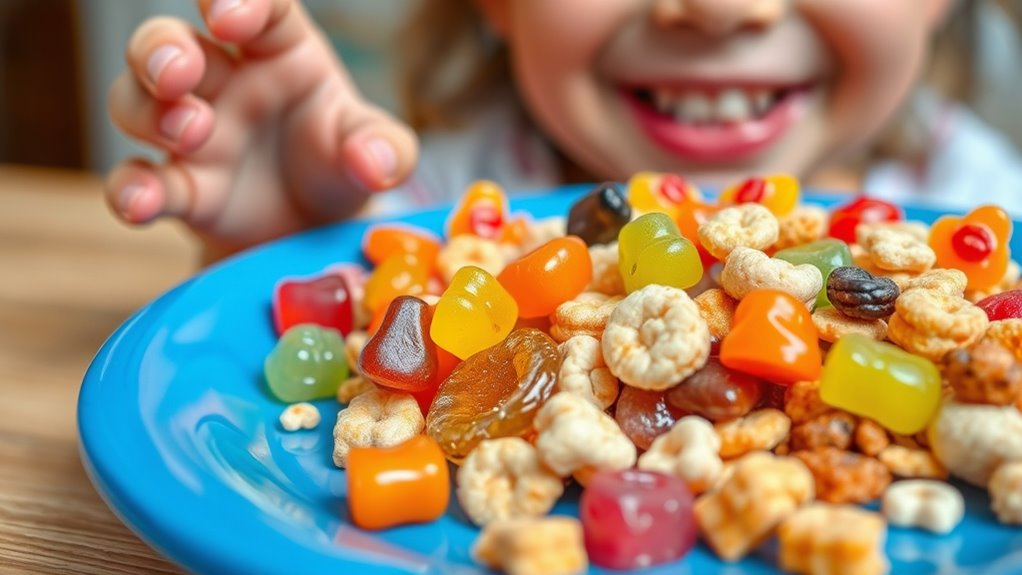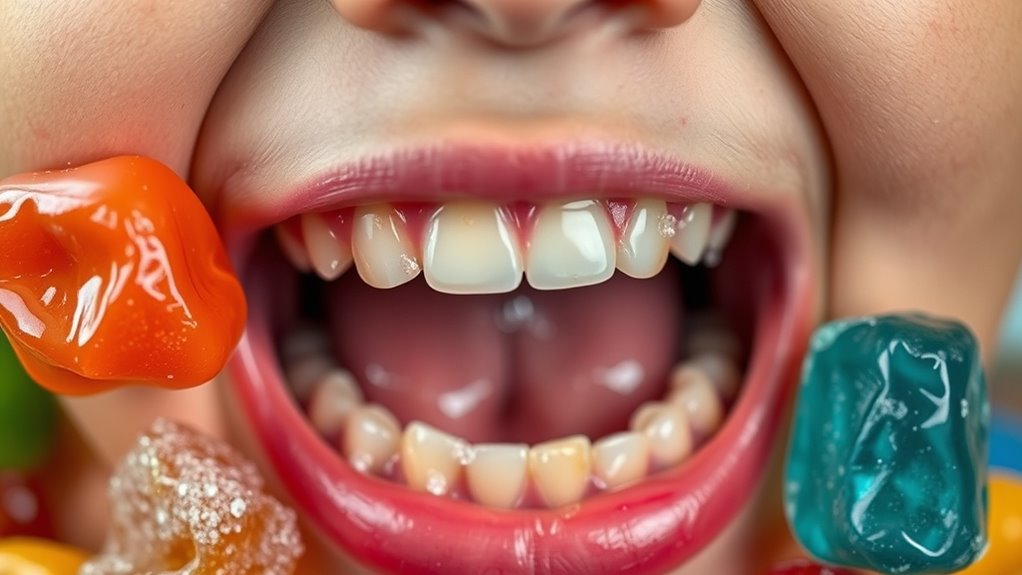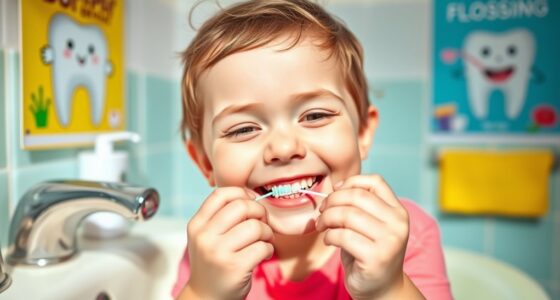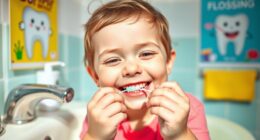The main causes of tooth decay in children include bacterial activity that forms plaque, which feeds on sugars and carbs from foods like candies, chips, and sticky snacks. Poor oral hygiene allows plaque and bacteria to build up, while acidic foods weaken enamel. Dry mouth reduces saliva’s protecting effects, making teeth vulnerable. Bacterial transmission from caregivers also plays a role. To discover more about preventing cavities and keeping your child’s smile healthy, explore further.
Key Takeaways
- Frequent consumption of sugary, sticky, and acidic foods promotes bacterial growth and enamel erosion in children.
- Inadequate brushing and flossing allow plaque buildup, increasing decay risk.
- Bacterial transmission from caregivers through saliva-sharing activities can introduce harmful bacteria early.
- Reduced saliva flow impairs natural enamel protection and clearance of food particles.
- Lack of professional dental care and preventive treatments like fluoride increase vulnerability to cavities.
Bacterial Activity and Plaque Formation

Have you ever wondered how bacteria contribute to tooth decay in children? Bacteria in your mouth feed on food particles left on your teeth and produce acids through bacterial activity. This acid production damages the enamel, leading to enamel erosion and cavity formation. Using proper oral hygiene techniques, such as brushing and flossing regularly, can significantly reduce bacterial buildup. Plaque, a sticky film composed of bacteria, food debris, acids, and saliva, forms on your teeth and provides a breeding ground for decay-causing bacteria. If you don’t maintain good oral hygiene, plaque hardens into tartar, making it tougher to remove bacteria. Persistent plaque buildup weakens the enamel over time, increasing the risk of cavities. Regular brushing and flossing help remove plaque and food particles, preventing bacterial activity from escalating and protecting your child’s teeth from decay. Consistent oral care is essential in disrupting the cycle of bacterial growth and safeguarding your child’s dental health.
Sugar and Carbohydrate-Rich Foods

Did you know that the foods your child eats can directly influence the development of tooth decay? Foods high in sugar and carbohydrates serve as fuel for bacteria, producing acids that attack tooth enamel. Starchy foods like bread and potato chips break down into sugars, feeding decay-causing bacteria. Sticky snacks such as caramel or dried fruits cling to teeth, prolonging sugar contact and increasing cavity risk. Sweets like candy, fruit juices, and sugary drinks cause repeated acid attacks, weakening enamel over time. Even healthier options like citrus and peanut butter can contribute if they stick to teeth. Incorporating home decor elements like wooden snack storage containers or linen utensils can promote a rustic, healthy eating environment. Additionally, understanding the role of agent programs in managing health information can help in tracking dietary habits that impact oral health. Visualize this:
| Food Type | Effect on Teeth |
|---|---|
| Candy & sugary drinks | Promote acid attacks, decay |
| Starchy foods | Break down into sugars, feed bacteria |
| Sticky snacks | Prolong contact, increase cavities |
| Fruits & spreads | Can stick, cause acid attacks |
Sticky and Acidic Snacks

Foods that stick to your child’s teeth, like caramel, taffy, and dried fruits, can substantially increase the risk of cavities. Sticky snacks trap sugar and bacteria, prolonging contact with teeth and accelerating tooth decay.
Here are some ways they affect your child’s oral health:
- Sticky snacks cling to teeth, leading to sugar retention and promoting bacterial growth.
- Dried fruits and peanut butter can remain on teeth, increasing cavity risk.
- Acidic foods like citrus weaken enamel, making teeth more prone to erosion.
- Frequent snacking on sticky and acidic foods without proper oral hygiene heightens the chance of dental cavities.
To protect your child’s teeth, limit these snacks and ensure thorough brushing after consumption to prevent enamel erosion and cavities.
Poor Oral Hygiene Practices

Poor oral hygiene practices considerably increase your child’s risk of cavities because neglecting proper brushing and flossing allows plaque and food particles to build up on teeth. Inadequate brushing for less than two minutes leaves behind plaque and sugars that fuel cavity-causing bacteria. Flossing neglect or improper technique fails to remove food debris and bacteria trapped between teeth, where toothbrushes can’t reach. Relying solely on brushing can leave sticky foods that promote bacterial growth, increasing the risk of tooth decay. Poor oral hygiene habits lead to higher levels of cavity-causing bacteria in your child’s mouth, accelerating decay development. Consistently poor oral hygiene hampers plaque removal, allowing plaque accumulation and bacteria proliferation, which ultimately results in a higher likelihood of cavities and damaged teeth. Additionally, using electric toothbrushes can improve plaque removal efficiency, thereby reducing the risk of decay. Incorporating proper oral hygiene techniques is essential for maintaining oral health and preventing cavities. Maintaining a consistent oral hygiene routine helps in reducing bacterial buildup, preventing the formation of cavities. Regular dental check-ups also play a critical role in early detection of decay, enabling prompt treatment before cavities worsen.
Reduced Saliva Flow and Dry Mouth

Reduced saliva flow considerably raises your child’s risk of cavities because saliva plays a vital role in protecting teeth. When your child has dry mouth, less saliva means reduced saliva flow, which hampers enamel mineralization and the natural process of remineralization. This leaves teeth more vulnerable to dental decay.
Here’s what happens:
- Food particles and sugar linger longer, fueling bacteria in mouth.
- Plaque buildup increases, trapping bacteria that produce acid.
- Acid erosion damages enamel, weakening tooth structure.
- Fewer minerals like calcium and phosphate are available to repair early decay.
Without enough saliva, the mouth can’t effectively neutralize acids or wash away bacteria, heightening cavity risk. Dry mouth creates an environment where bacteria thrive, accelerating dental decay in children. Additionally, salivary gland function can decline due to various factors, further reducing saliva production and increasing decay risk. Saliva’s protective role is essential in maintaining oral health by safeguarding against these processes. AI detection methods are continuously improving to identify and address oral health information, aiding in early diagnosis and prevention efforts.
Transmission of Bacteria From Caregivers

Dry mouth and decreased saliva flow can make your child’s mouth more vulnerable to decay, but bacteria transmission from caregivers also plays a vital role in early dental health. Saliva-sharing activities, like licking a pacifier or cleaning a bottle with your mouth, facilitate bacteria transmission of cavity-causing bacteria such as Streptococcus mutans. Early bacterial transfer often occurs before teeth erupt, setting the stage for future decay. Children whose caregivers have high levels of these bacteria are more likely to develop early dental caries. Practicing good oral hygiene, avoiding saliva contact during feeding, and regularly cleaning pacifiers can markedly reduce bacterial transmission. Additionally, understanding factors like oral microbiome diversity can help in developing better preventive strategies. Understanding how saliva and oral bacteria interact emphasizes the importance of color accuracy in maintaining overall oral health and preventing decay. The role of hygiene practices in reducing bacterial spread cannot be overstated in safeguarding your child’s developing teeth from decay. Incorporating early intervention strategies, such as fluoride treatments, can further strengthen your child’s teeth against decay. Implementing routine dental visits can further help monitor and manage bacterial levels to protect your child’s oral health. Preventing the spread of bacteria from caregivers is essential in protecting your child’s developing teeth from decay.
Frequently Asked Questions
What Are the Main Causes of Tooth Decay in Children?
You might wonder what causes tooth decay in children. It mainly happens when bacteria in their mouths feed on sugars from foods and drinks like candy and soda, producing acids that erode enamel.
Poor brushing habits and not flossing allow plaque to build up, while starchy foods release additional sugars.
Reduced saliva flow also plays a role, as it can’t neutralize acids effectively, increasing the risk of cavities.
What Are the 4 Causes of Tooth Decay?
You’re asking about what causes tooth decay. The main culprits include bacteria in your mouth that produce acids from sugars and starches, which damage your enamel.
Consuming lots of sugary and sticky foods prolongs this acid exposure.
Poor oral hygiene, like not brushing or flossing enough, allows plaque to build up.
Ultimately, reduced saliva flow means your mouth can’t naturally wash away acids, increasing decay risk.
What Is the Most Common Childhood Disease of Tooth Decay?
Imagine your child’s teeth as a fortress under attack; tooth decay is the most common invader, affecting nearly 1 in 5 children aged 5 to 11. It’s a persistent enemy caused by bacteria converting sugars into acids that erode enamel.
What Deficiency Causes Tooth Decay in Kids?
You want to know what deficiency causes tooth decay in kids. When children lack enough fluoride, their enamel weakens, making teeth more prone to decay.
Insufficient calcium and vitamin D also play a role by impairing mineralization and enamel strength.
Additionally, low vitamin A reduces saliva production, decreasing natural protection.
Addressing these deficiencies through proper nutrition and fluoride exposure can help keep their teeth healthy and decay-free.
Conclusion
By understanding these causes, you can protect your child’s smile like a knight guarding a castle. Think of bacteria as invaders, sugar as their fuel, and poor hygiene as open gates. When you prioritize good brushing, limit sugary snacks, and foster healthy habits, you’re building an invisible shield. Just as a garden needs tending, your child’s teeth thrive with care—turning potential decay into a distant memory, and ensuring their bright future stays sparkling.








